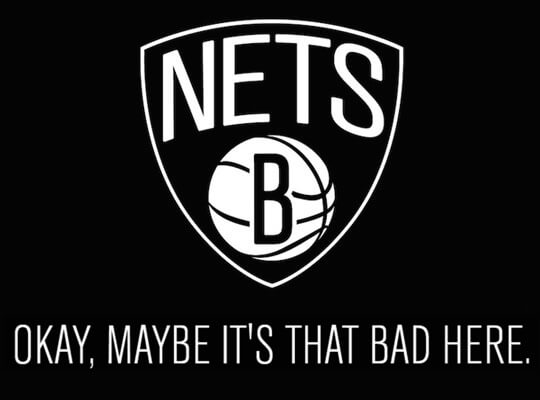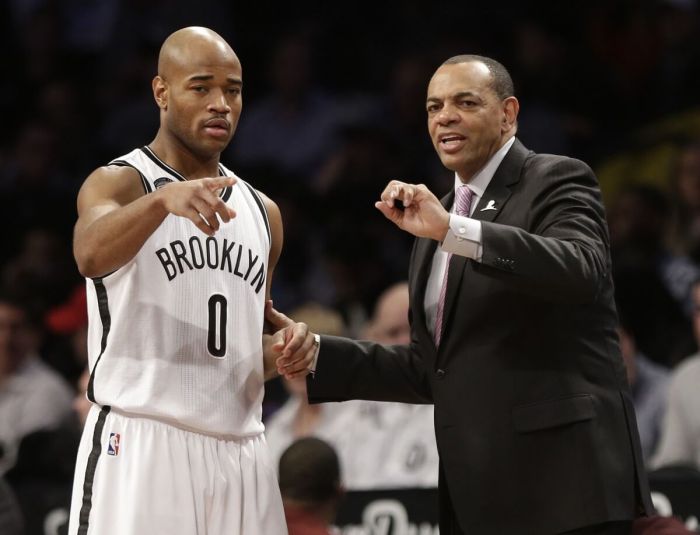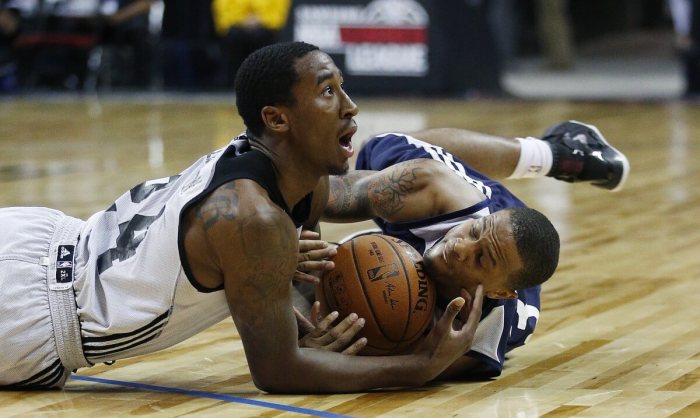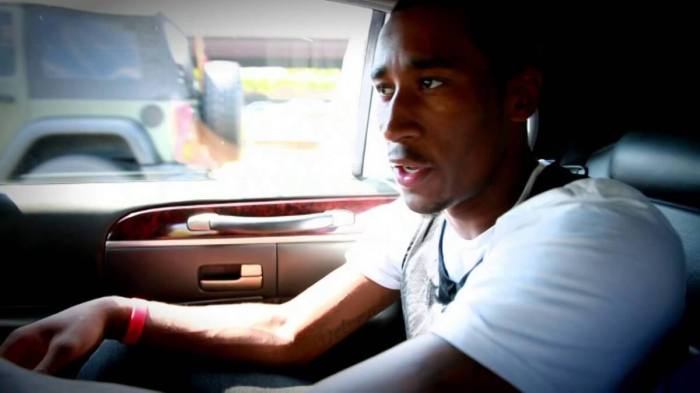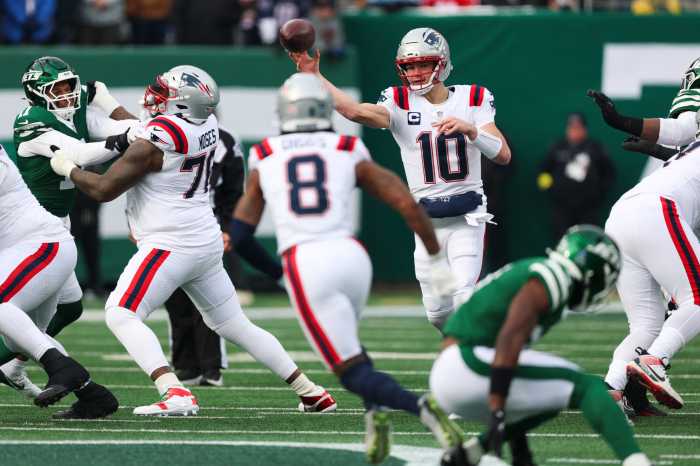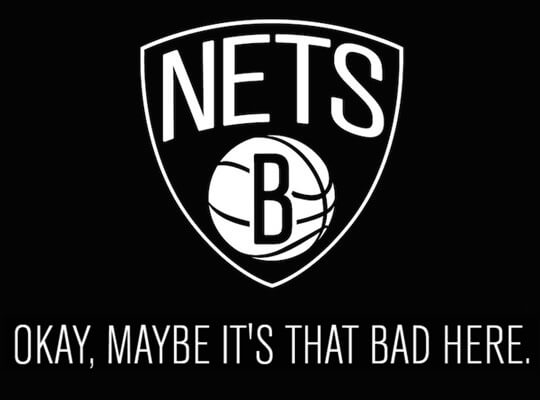
Periodically, we’ll check in on the status of how bad things are here, in honor of Joe Johnson’s priceless preseason quote. Statistical support throughout provided by NBA.com.
This has been ugly. You won’t hear anything else, anywhere. The Nets haven’t won a game since April, they’ve collapsed down the stretch in their few winnable moments, and the schedule only gets tougher from here. Here’s 10 things worth noting.
1) This isn’t as bad as 12-70 on the court, but it’s close. The 2009-10, 12-70 New Jersey Nets had a worse net rating through seven games, shot worse from the field (even considering this current team’s woes from three-point range), was worse on the glass, and relied on Rafer Alston as a leading point guard for long stretches. The Brooklyn Game, in its infant stages way back in 2009 as Nets Are Scorching, served as an outlet for a flabbergasted Sebastian Pruiti to wonder aloud about why the team was ignoring Brook Lopez. That team was 7-63 before a late, lucky flurry got them to 12 wins. This team has no shortage of problems, but it’s not quite that bad yet.
2) This is worse than 12-70 off the court. At least at the end of 12-70 came a top-three draft pick and the beginning of a rebuild. Barring a surprise splash in free agency, the Nets are currently in the midst of the slowest rebuild the league has ever seen. At least in most bad years, there’s light at the end of the tunnel. Brooklyn’s tunnel warps to Boston.
Here’s a thought exercise. Say the NBA lifted their sanction on the money (currently a maximum of $3 million per season) you could send in trades; i.e. any team could send any amount of money to facilitate a deal. How much do you think the Nets would send to Boston to get their first-round pick back? How much do you think Boston would need to get it done? Remember, the Nets saved $60 million this year (closer to $40 million when all is said and done) by waiving and stretching Deron Williams’s contract. Is it crazier that they could logically put that $60 million towards recovering their draft pick, or that Boston probably wouldn’t take it since the value of that pick could last them eight-plus years?
3) The revisionist history about “The Trade” is bugging me. The reason the rebuild is so slow is because of “The Trade,” and you already know which The Trade: the one that sent the team’s 2014, 2016, 2017 (via swap), and 2018 draft picks to the Boston Celtics for one year of Paul Pierce and 1.5 years of Kevin Garnett.
But people have forgotten what the initial perception of that trade was. The reaction to the trade was overwhelmingly pro-Nets. Celtics fans were in disarray. Even the people who were worried about losing the picks in the long-term didn’t anticipate a drop-off like this, myself included.
Remember, Deron Williams was coming off his best three months in Brooklyn. He’d been arguably a top-10 player following the All-Star Break. Brooklyn’s biggest problems at that point were defense, spacing, and executing a gameplan for 48 minutes; they replaced Reggie Evans and Gerald Wallace with Kevin Garnett and Paul Pierce. ESPN’s early projections had them winning 64 games once they’d added Andrei Kirilenko to the mix.
The idea was that they’d compete for a championship for one to two years, and even if they didn’t win one, they’d still have had two strong, competitive seasons to entice free agents. There was no reasonable argument that it would get this bad, because what’s happened to the Nets defies reason.
Of course, the trade looks awful now. Setting-a-franchise-back-a-full-decade awful. It deserves criticism as a shortsighted move, and the lack of protection on those picks is the real doozy. But that wasn’t a concern then, for fans of either team. For those of you wondering how anyone was allowed to make such a bad move, let’s not forget why the trade was made in the first place. Hindsight is an easy prescription.
4) Despite everything, Brook Lopez is quietly having a good season. Before the foot injury sent a shiver down the spine of the few tortured souls still watching this team, Brook Lopez was in the midst of another solid game against the Bucks, finishing with 20 efficient points in 29 minutes.
Lopez got the lion’s share of his buckets by holding down the paint, both slipping under the defense and establishing deep post position. The Bucks decided to front Lopez, which isn’t a bad strategy given the Nets’ lack of solid playmakers. But they were still able to take advantage, because Lopez is both enormous and deft. Watch how closely Lopez sticks to the basket: he barely stretches eight feet after getting under Monroe.
When Monroe fronts here, the Nets immediately recognize it and swing into action with a bang-bang look to get Lopez an open shot at the rim.
Lopez has also become a more willing passer, with 12 assists through the first seven games. For most players, 12 assists in 7 games wouldn’t mean much, but that’s almost double his assists per game from last season. Certainly, there’s a lot of work to be done throughout the offense, but if Lopez can stay on track — and on the court — that’s a positive.
5) The jury is out on the Young-Lopez combo. Both Thaddeus Young and Brook Lopez re-signed with the Nets largely on the faith the two had in one another. Following the All-Star Break, the Nets outscored opponents by 3.2 points per 100 possessions, not an insignificant number for an otherwise struggling team, but one that was buoyed by the strength of late-season opponents.
It’s early, but the returns haven’t been positive. The Nets have been outscored by 11.8 points per 100 possessions with the two players on the floor, right around the team’s overall average. To their credit, the two hitting shots inside is the only reason that the Nets have stuck around in some games this season, and the difference was felt in the fourth quarter against the Bucks Saturday night. But it has not been a promising start.
6) Besides Lopez, the Nets lack finishers. Nets players who aren’t close personal friends with Bill Clinton are shooting 51.3% from within five feet this season.
This isn’t altogether surprising. Joe Johnson, Jarrett Jack, and co. are floater-heavy shooters, who prefer to pull up in the lane than attack the basket directly. The Nets have had so few finishers in Brooklyn that Joe Johnson once referred to Alan Anderson, an average NBA athlete, as a high-flyer. Beyond Thomas Robinson and Rondae Hollis-Jefferson, there’s not many players on the Nets who get “up” at the rim.
7) So far, Jarrett Jack is who we thought he is. It was clear before the season that the Nets would not and could not succeed without at least one primary distributor on the floor. Before the season started, the hope — not the assumption — would be that Jarrett Jack, now in a veteran role surrounded by shooters, would be that player. According to Nets general manager Billy King, Hollins told Jack “you told on yourself” during an offseason workout in which Jack made the right pass out of a pick-and-roll.
Through seven games, turns out that’s not the case. Jack leads the team in assists, but that’s as much a function of the role as anything else: he has the ball in his hands more than anyone else, and he trails Joe Johnson in the percentage of his frontcourt touches that end in an assist or a pass that leads to a shooting foul. (Jack actually leads not just Johnson, but the entire NBA, in “hockey assists,” largely a function of — you guessed it — hitting Johnson and watching Johnson create.)
Among point guards with at least 30 drives to the basket, Jack ranks with the highest percentage of drives that turn into shots, and the lowest percentage of drives that become passes. Because the majority of Jack’s shots are floaters, he has rarely drawn contact, and has only gone to the foul line twice on drives as a result.
8) The team’s shooters, however, are not what we thought they were. It would be easier to further criticize Jack if any of the shooters he should be passing to were, you know, making shots. This is the story of the Nets season thus far: there is a veteran NBA team that’s made five or fewer three-pointers in a professional basketball game in six out of their first seven games in 2015. Only the Minnesota Timberwolves (four games) have hit five threes or less more than three times in the season’s first two weeks. Only two Nets are hitting above even 30 percent from three-point range, and one of them (Andrea Bargnani) is 1 for 3.
The Nets don’t lack shooters. Bojan Bogdanovic hit 35.5% of his threes last year and 43.5% after the All-Star Break. Joe Johnson is a career 37% three-point shooter. Wayne Ellington hit 38.2% last year with the Lakers, a team that values spacing like Donald Trump values humility. Prior to joining the Nets last year, Jarrett Jack had hit 35.6% of his career threes. Sergey Karasev and Shane Larkin hadn’t shown it much at the NBA level yet, but both came into the league with a shooting pedigree.
But nothing’s working. In a league where almost every team is taking more threes, the Nets are going in the opposite direction, and they’re not converting the few looks they get. The team has shot 21-for-87 (24.1%) on threes considered “open” (four feet or more between them and the nearest defender) this season, and is the worst team in the league at taking, hitting, and converting non-corner threes (11-for-69).
The good news in that muck: they can’t possibly get any worse than this, and shooters tend to make shots over time. They’re not getting a lot of open looks, but they’re getting enough that they should be able to knock more down as the season progresses. But when your good news is that you’re at rock bottom… That’s not exactly good news.
9) Andrea Bargnani shoots… fast. There’s only one way to illustrate just how quickly Andrea Bargnani is letting the ball leave his hands.
It’s there. You can never take it back. (I’m saying these things to myself.)
This isn’t a positive or negative video: it shows both made shots and missed shots, and it’s smart to take open shots when you’ve got them. Bargnani has gotten those looks consistently at the elbow this year. But nobody is anteing up faster than Andrea Bargnani.
10) Anointing Rondae Hollis-Jefferson as the future savior. Hollis-Jefferson is the team’s most exciting rookie since Derrick Favors. He’s lithe, agile on the defensive end, and young enough that you can envision him developing a reliable jump shot. His plus-minus also shatters anyone else on the team so far through seven games: he’s the only rotation player with a positive plus-minus, and nobody else is particularly close.
Hollis-Jefferson is a solid young player, and the Nets haven’t had many of those in recent years. But his plus-minus will go down, and he’ll show some rookie bumps and bruises as the season goes on. It’s part of the maturing process in the NBA. It’s not as though the Nets will suddenly become a playoff contender if they start playing him 40 minutes per game. The exciting thing about Hollis-Jefferson is that he’ll have the chance to develop over time. But putting too many expectations on a late first-round pick this early is a recipe for failure.

